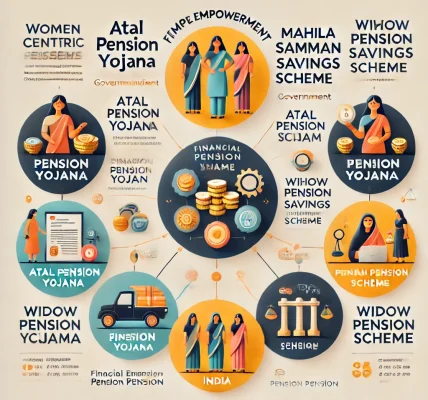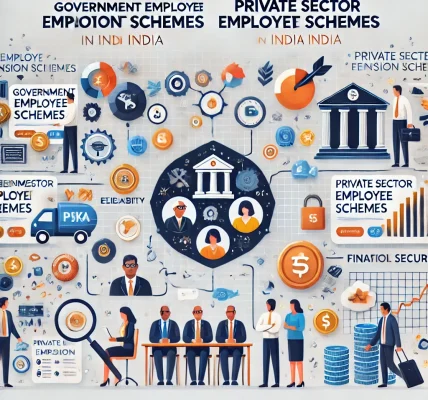Introduction
Retirement planning is crucial for financial security in old age. One of the most significant aspects of retirement planning is selecting the right pension scheme. While government employees enjoy traditionally strong pension benefits, private employees have multiple investment options for securing their future.
In this blog, we will compare pension schemes for government employees vs. private employees to help you determine which option is better for long-term financial security.
Key Differences Between Government and Private Employee Pension Schemes
| Feature | Government Employees | Private Employees |
|---|---|---|
| Job Security | High | Moderate to Low |
| Pension Type | Defined Benefit (DB) or Defined Contribution (DC) | Mostly Defined Contribution (DC) |
| Pension Guarantee | Guaranteed pension for life | Depends on investment performance |
| Government Support | Backed by the government | No government backing |
| Tax Benefits | Yes, under Section 80C, 80CCD | Yes, under Section 80C, 80CCD |
| Early Withdrawal | Restricted | Allowed in certain cases |
Pension Schemes for Government Employees
Government employees in India are entitled to structured pension plans, ensuring financial security post-retirement. The two primary pension schemes include:
1. Old Pension Scheme (OPS) (For employees who joined before 2004)
- Defined Benefit Plan: Guarantees a pension based on the last drawn salary.
- No Employee Contribution: Entire pension amount funded by the government.
- Dearness Allowance (DA) Adjustments: Pension amount increases with inflation.
- Lifetime Pension with Family Benefits: Surviving spouse/children receive pension after the retiree’s death.
2. National Pension System (NPS) (For employees joining after 2004)
- Defined Contribution Plan: Pension depends on contributions and market performance.
- Employee & Government Contributions: Both contribute 10-14% of the employee’s basic salary.
- Market-Linked Returns: Investments in equities, bonds, and government securities.
- Annuity Purchase Required: At least 40% of corpus must be used to buy an annuity for lifelong pension.
- Tax Benefits: Deductions under Section 80CCD(1), 80CCD(1B), and 80CCD(2).
Pension Schemes for Private Employees
Unlike government employees, private employees do not have guaranteed pension benefits. However, several retirement schemes are available:
1. Employees’ Provident Fund (EPF)
- Mandatory for Companies with 20+ Employees.
- Employee Contribution: 12% of basic salary.
- Employer Contribution: 12% (8.33% to EPS and 3.67% to EPF).
- Interest Rate: Generally higher than savings accounts (currently around 8% p.a.).
- Tax-Free Withdrawals: After 5 years of continuous service.
2. Employees’ Pension Scheme (EPS)
- Pension for Private Sector Employees with EPF.
- Government-Backed Scheme: Part of employer’s EPF contribution.
- Minimum Service: 10 years required for pension eligibility.
- Fixed Monthly Pension: Based on years of service and last drawn salary.
3. National Pension System (NPS)
- Voluntary retirement plan for private employees.
- Higher returns than traditional pensions.
- Can invest in Equities, Corporate Bonds, and Government Securities.
- Tax benefits under Section 80CCD(1) & 80CCD(1B).
4. Public Provident Fund (PPF)
- Long-term savings option with a 15-year lock-in.
- Tax-free returns under Section 80C.
- Interest Rate Set by Government (Around 7% – 8%).
5. Superannuation Fund
- Employer-Sponsored Pension Plan.
- Limited to Certain Private Companies.
- Tax Benefits Available.
Government Pension vs. Private Pension: Which One is Better?
To determine which pension scheme is better, let’s compare key aspects:
1. Financial Security
- Government Employees: Get guaranteed pensions, ensuring stability in retirement.
- Private Employees: Depend on savings and market-linked returns, which may fluctuate.
Winner: Government Employees
2. Flexibility
- Government Pensions: Limited investment options and strict withdrawal rules.
- Private Pensions: More flexibility in choosing funds, withdrawing funds, and diversifying investments.
Winner: Private Employees
3. Investment Returns
- Government Schemes: Provide lower but guaranteed returns.
- Private Schemes: Market-linked investments may yield higher returns over time.
Winner: Private Employees (for high-risk investors)
4. Early Withdrawal Benefits
- Government Pensions: Early withdrawal not allowed in most cases.
- Private Pensions: Some flexibility in withdrawing funds (EPF, PPF, NPS).
Winner: Private Employees
5. Tax Benefits
- Both Government and Private Employees enjoy tax benefits under Section 80C and 80CCD.
Winner: Tie
Conclusion: Which Pension Scheme is Best?
- For Risk-Averse Individuals: Government Pension Schemes are better due to stability and lifelong benefits.
- For Growth-Oriented Investors: Private Pension Schemes (NPS, PPF, EPF) offer better long-term returns.
- For Flexibility: Private employees have more investment choices and withdrawal options.
Final Verdict:
✅ Government Pension is better for stability & guaranteed income. ✅ Private Pension is better for high returns & investment flexibility.
FAQs
Q1: Can private employees enroll in government pension schemes? Yes, private employees can invest in NPS, PPF, and EPF for retirement benefits.
Q2: Is the Old Pension Scheme (OPS) still available? No, OPS has been replaced by NPS for new government employees.
Q3: Which pension scheme provides the highest returns? Among government-backed schemes, NPS offers the highest returns (8%-12% p.a.).
Q4: Can private employees receive a lifetime pension? Yes, through EPS and annuity plans under NPS.
Q5: Is EPF better than NPS? EPF offers stable returns with guaranteed interest, while NPS has higher returns but is market-linked.
Final Thoughts
Both government and private pension schemes have their advantages. While government employees enjoy lifelong pension security, private employees have diverse investment options with potential for higher returns. Choosing the right pension scheme depends on your career, risk appetite, and financial goals.
If you’re a private employee, start investing early in NPS, PPF, or EPF to build a secure retirement corpus. If you’re a government employee, ensure you maximize your NPS contributions for better returns. Either way, planning today ensures a financially secure tomorrow!



